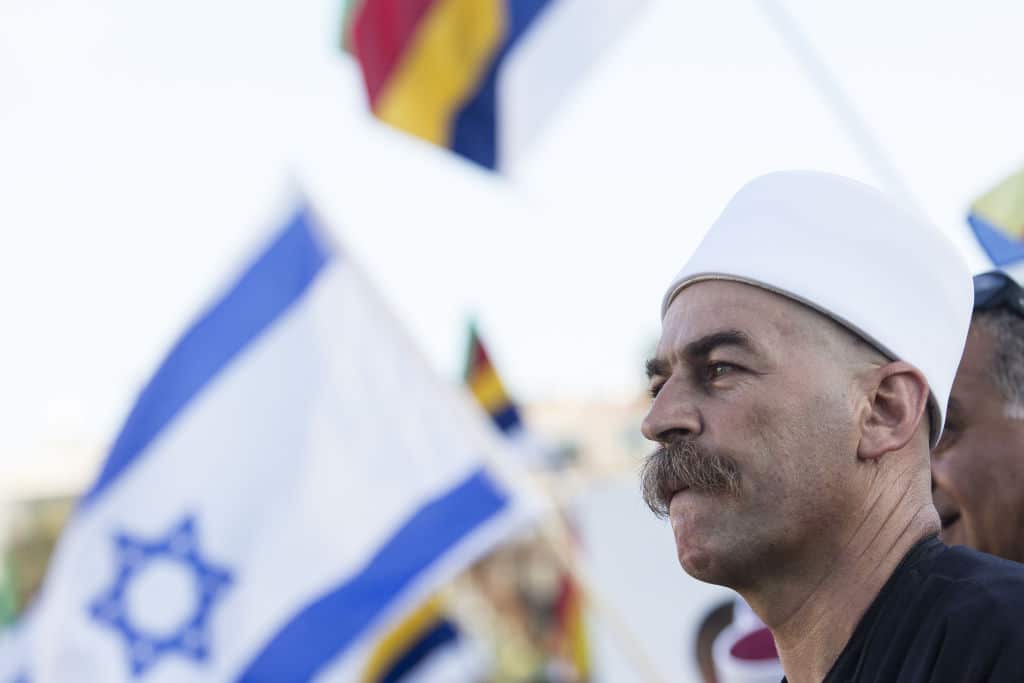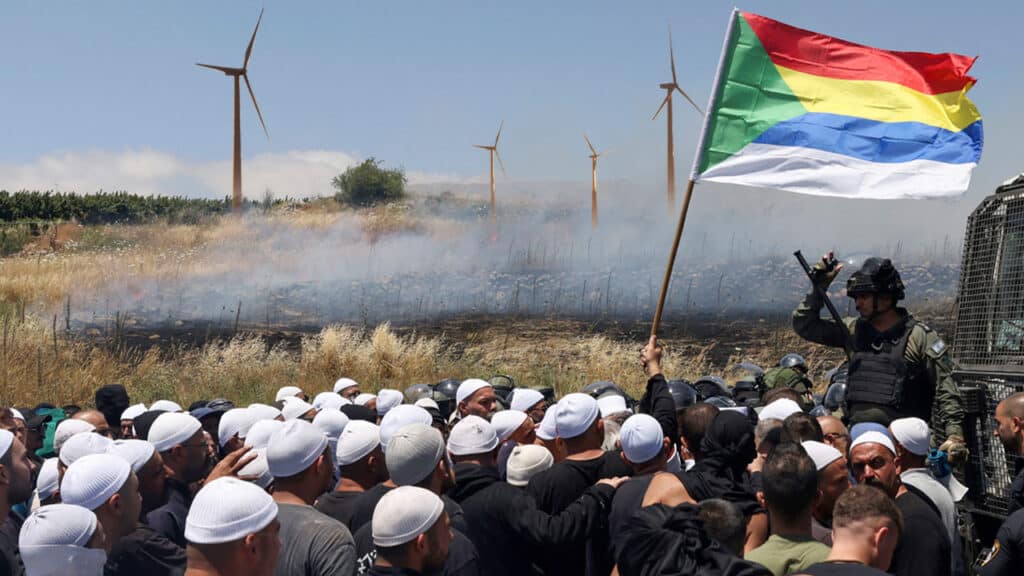It’s not unusual to hear about conflict in Israel. But recently, the Druze, a group not known for wreaking havoc, started rioting in Israel’s streets.
Thousands have protested throughout the Golan Heights, hurling rocks, fireworks and Molotov cocktails at the police. The heart of the matter? A controversial government plan to construct dozens of wind turbines in the area, triggering a surge of opposition and protest.
During a substantial protest on June 21, a dozen law enforcement officers sustained injuries, while eight of the demonstrators were wounded.
Meanwhile, Sheikh Muafak Tarif, the leader of the Druze community in Israel, warned the government to stop the turbine project in the Golan Heights, or face “a reaction the country has hitherto not seen.”
As of now, Prime Minister Benjamin Netanyahu has suspended the controversial turbine project. This week, we wanted to explore: What was behind the recent protests from this usually peaceful community, known for its strong bond with the state of Israel and a tradition of service in the IDF?
Who are the Druze?
Numbering around one million people worldwide, the Druze are a unique religious and ethnic group that originated in the 10th century in Egypt, when they branched off from Islam.
Identifying as Arabs and speaking Arabic, the Druze faith combines aspects of Islam, Hinduism, and classical Greek philosophy. Yet, their actual doctrines are a secret, guarded closely by their religious leaders.
The majority of the Druze population resides in Syria and Lebanon, with around 143,000 (less than 2% of the country’s total population) settled in Israel’s northern regions of Carmel, the Galilee, and the Golan Heights.
A defining aspect of the Druze community is their unwavering loyalty to the country in which they live, rooted in their religious ethos.
This principle is starkly evident in Israel, where 85% of Druze men serve in the IDF, primarily in combat units, surpassing the 73% service rate of Israeli Jews.
This sense of duty and allegiance has cost 421 Druze lives, lost in the IDF or to terror attacks as of 2017. The bond between the Druze and the Jewish state is often referred to as a “covenant of blood” or “brit damim,” underscoring their shared loyalty and sacrifice.
Tracing the ancient roots of the Druze and Jewish communities
But the deep bond between the Druze and Jewish communities goes back even further — all the way to Biblical times.
The Druze consider Moses’ father-in-law, Jethro, to be their main prophet and spiritual founder. Jethro became Jewish and devoted himself to the people of Israel, so it makes sense that the Druze would feel a strong connection with the Jewish people.
Fast forward to the days of the British Mandate of Palestine, and the Druze and Jews started forging alliances. During this turbulent time, occasional conflicts erupted between the Druze and Muslim communities.
Rami Zeedan, a professor at the University of Kansas and an expert on Israeli Druze history, explained: “Both communities were minorities at that time. So some Druze villages established individual alliances with the Jewish communities around them.”
On the eve of Israel’s 1948 War of Independence, the Jewish and Arab communities each pressured the Druze to join their side. Initially, many Druze leaders preached a stance of neutrality in the conflict.
According to Yoav Gelber, a history professor at the University of Haifa and author of “Jews and Druze in the War of 1948,” there was a difference of opinion among Druze leaders about whether this neutrality was a mask to conceal their real position of support for the Jews, or whether their position was actually impartial.
Meanwhile, Gelber writes, “the IDF, the Foreign Ministry and Daat [the predecessor of the Mossad], were all active…in cultivating the Druze connection.”
The Jewish community’s efforts ultimately prevailed, and the Druze community fought alongside Israel during the 1948 War of Independence.
The communities grew closer following the establishment of the state. In 1956, Israel passed a law extending mandatory military service to Druze men.
While some historians argue that the Druze acquiesced to conscription due to pressure from the Israeli government, others say the Druze leadership actually asked the government to make the change. They believed that military service would bolster their integration into Israeli society.
The Druze and the Jewish state today
Indeed, today, the Druze are known as the most integrated Israeli minority. The Druze community is highly represented in Israel’s government, serving as Knesset members, diplomats and IDF officials.
Relative to the small size of their population in the country, they are integrated into Israeli society at an extraordinary level. At the same time, the Israeli Druze experience has been far from perfect.
In 2018, many Israeli Druze were enraged when the Knesset passed the controversial nation-state law. Tens of thousands flocked to Tel Aviv to protest the legislation.

Though mostly symbolic, the law defined Israel as the national home of the Jewish people but didn’t restate equality for all Israeli citizens, as mentioned in Israel’s Declaration of Independence.
The legislation also relegated Arabic to a “special status,” causing Druze — who have fully dedicated themselves to Israel — to feel their language was not considered on par with Hebrew.
Samir Al-Assad, an Israeli Druze Lieutenant Colonel, expressed this sentiment: “Israel is my country, I am proud to be an Israeli. But this law made me feel humiliated.”
Despite the protests against the nation-state law, the majority of Druze pledged to continue serving with dedication in the army because Israel is their home.
Israeli Druze leader Sheikh Muwafaq Tarif articulated this commitment: “Despite our utter loyalty, the state does not see us as equal. Just as we fight for the existence and security of the state, so we are determined to fight together for the character and right to live in it in equality and dignity.”
The conflict of the turbine project

According to reporting by the Hebrew Makor Rishon newspaper, in 2019, the Israeli government approved a significant energy project, which was then supported by the Druze living in the Golan Heights, their leaders, and the heads of the Golan Heights council.
The project, centered around the construction of wind turbines, aimed to generate electricity for 50,000 households each year.
The chosen location for the turbines was on privately owned land, close to the Israel-Syria border. The Druze landowners agreed to rent their land for this initiative, and for the past three years, they received payments based on the size of their land.
However, the project drew criticism from the Syrian Druze residing across the border. They perceived the project as an encroachment on what they consider Syrian territory and began mobilizing against it. Through videos and messages, they appealed to their Druze counterparts in Israel to resist the project vehemently.
What’s causing the uproar over the wind turbines?
In response to the growing opposition, the Israeli Druze community began to question the underlying implications of the turbine project.
The concern revolves around the intended construction of these turbines on Druze lands, which are not only their homes but also a crucial source of income through agriculture and tourism. Many Druze fear that the turbines could jeopardize their livelihood.
The Golan is renowned for its beauty, but concerns arise about how enticing it will remain with constant humming and flashes of light from towering turbines altering the skyline.
Intensifying these concerns are historical loyalties. The Druze of the Golan, once under Syrian control, held a fierce loyalty to Syria. Their loyalty was tested when Israel captured the Golan Heights from Syria in 1967.
Abruptly cut off from Syria, many Druze in the Golan maintained their strong Syrian ties, opting not to become Israeli citizens. However, younger generations are beginning to perceive the benefits of Israeli citizenship, creating a tension of loyalties that still persists among the Druze in the Golan.
Adding fuel to the fire is the sense of being cornered in a construction crisis. The Druze are still reeling from the 2017 Kaminitz Law, which stipulates harsh penalties for unauthorized construction.
The law redesignated ancestral lands legally owned by the Druze as agricultural, limiting their rights over these lands — especially in terms of building or development.
Salim Brake, an expert on Druze society in Israel who teaches political science at the country’s Open University, explained: “Young Druze men, after faithfully serving in the IDF, find themselves unable to build homes in their villages. The Kaminitz Law feels discriminatory and racist to them. They see no way out.”
Despite the tenfold growth of the Druze community since 1948, there have been no new Druze villages established.
The recent protests are not merely about the turbines. The Druze community feels undervalued, discriminated against, and relegated to the status of second-class citizens. Financial losses from the turbine project compound their worries.
Although the project has been suspended for now, the Druze protests have revealed deeper issues. Here are three takeaways of the bigger picture.
1. Steadfast loyalty shouldn’t be presumed.
The extraordinary bond between the Druze and the Jewish people has fostered a unique sense of unity and cooperation.
The Israeli Druze have contributed significantly to Israeli society, particularly in terms of national security. But we must remember that this steadfast loyalty shouldn’t be presumed.
Historical accounts show that there were times of conflict, such as the revolt in Tzfat in the 1830s when Druze rebels attacked the Jewish quarter, leading to chaos and destruction.
The alliance between the Druze and Jewish people, though strong today, wasn’t always present — and we cannot take its permanence for granted.
2. Tension could spread to the rest of the Druze community.
The majority of the Druze outside the Golan have a strong affinity for Israel and their Druze heritage. Historically, Israel has been fortunate to have the unyielding support of this community.
However, as the wind turbine situation continues to inflame feelings of being taken for granted, the tension might spread across the entire Druze community, putting at risk the long-standing bond with Israel.
3. How can Israel be a Jewish state and protect minorities?
The Druze community’s discontent about perceived second-class citizenship raises a core question about Israel’s identity. How can we maintain Israel as the Jewish national home while ensuring the honor and protection of its minority populations?
Part of the challenge of a diverse society is balancing the needs and interests of multiple groups. It’s clear that Israel needs to recalibrate.
While some might view these protests as a challenging uprising by a previously peaceful group that needs to be suppressed, it could also be seen as an opportunity.
This is a chance for Israel to become a more inclusive and welcoming place for its minorities and to appreciate a community that has contributed significantly to shaping Israel into the country it is today.
